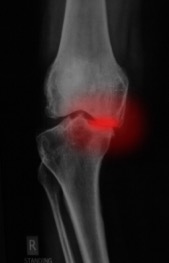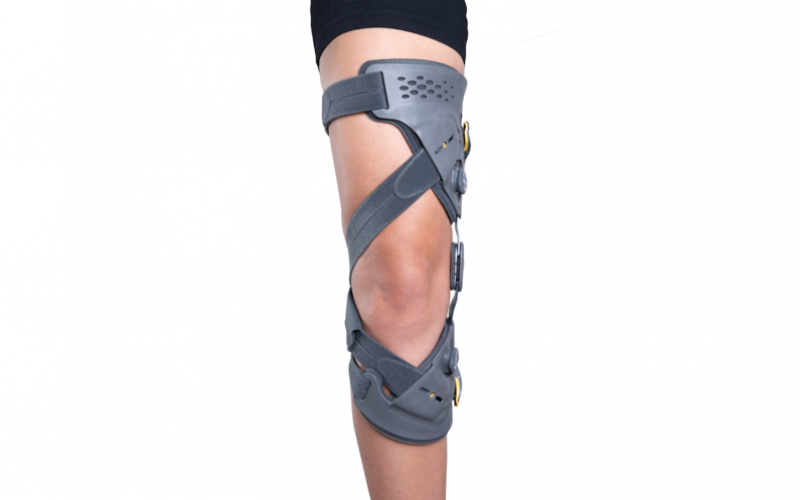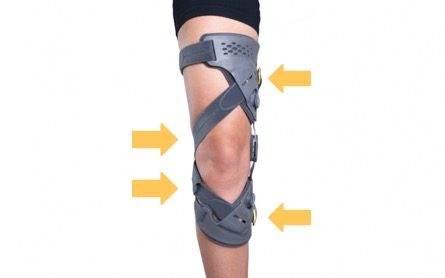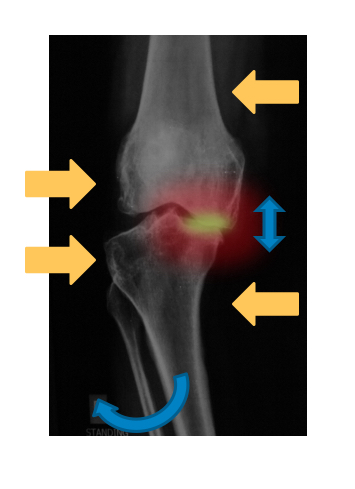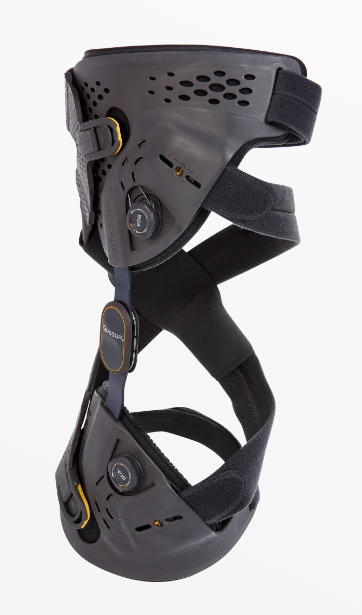Knee braces
The use of knee braces has become more common in recent years as bracing technology has progressed. Braces are employed as pain management tools, as a means of deferring surgery (sometimes by a number of years), to correct altered biomechanics and to protect damaged areas of the knee joint.
What is an offloading knee brace?
An offloading knee brace, as the name suggests, is designed to transfer the load from an affected compartment/side of the knee to a less affected compartment/side. The purpose of this is to reduce the load on the affected compartment and thereby reduce pian, which in turn can lead to an increase in activity levels and quality of life. Offloader braces are also used to try and slow down the rate of wear and tear in the affected side of the knee, in order to delay (or sometimes avoid altogether) the need for knee replacement surgery.
Offloader braces can also be used as a trial, to see whether a patient might potentially be a suitable candidate for realignment osteotomy surgery.
How do they work?
If we look at a varus knee (bow-legged), because of the malalignment there is increased pressure on the inner (medial) side of the knee. This increased pressure causes pain and an increased rate of wear and tear. The more the cartilage on the inner side of the knee wears away, the less of a ‘joint space gap’ there will be, and hence the joint will ‘collapse’ into a bigger varus… which then puts even more pressure on the inner side of the knee… and hence a negative feedback loop is established with things spiralling down and getting increasingly worse.
When an offloader knee brace is applied, the brace is sized and fitted carefully to suitably match the size and shape of the patient’s knee, and then as the unloader mechanism is tightened, the brace ‘cranks’ the inner side of the knee open. This takes some of the weight off the inner side of the knee (i.e. unloading), pushing the weight-bearing axis and hence the load more towards the outer (lateral) side of the joint.
When are they used?
Offloading knee braces are used:
- in people with arthritis affecting just one side (compartment) of their knee; i.e. ‘unicompartmental arthritis’,
- for people who might be too young for knee replacement surgery,
- for people who might not be fit enough for surgery,
- to protect the knee during early recovery after knee realignment surgery,
- to offload a compartment of the knee after reconstructive surgery, such as meniscal transplantation, articular cartilage grafting or Biological Knee Replacement.
How effective are they?
Biomechanical studies have estimated that an offloader brace can reduce the force going through the relevant compartment of a knee joint by about 13%. This may not sound like much, but if you consider a 100kg man walking, then this is roughly equivalent to a 5 to 10kg dumbbell – and if could imaging carrying that around all day, that’s a lot of weight! CLICK HERE for further details.
Clinical studies have demonstrated that the use of an offloader brace can reduce pain and improve function: CLICK HERE for further details.
Studies have also shown that the use of offloader braces cost-effective too: CLICK HERE for further details.
What are the negatives?
The potential negatives of offloader knee braces are that:
- they can be obtrusive: they can be worn with shorts or under baggy trousers (like tracksuit trousers), but if you’re wearing jeans or proper trousers then the brace has to be worn over the trousers,
- the brace can rub and it can irritate the skin, and
- the brace may only provide limited benefit.
Conversely, the main advantage of an offloader knee brace is that it’s non-invasive, and it’s certainly a lot less hassle, pain and risk compared to knee replacement surgery!
What's the best brace?
My personal opinion is that the Össur Unloader One X brace is the best offloader brace on the market.
How much does an offloader knee brace cost?
These braces are robust and hard-wearing. They are designed to exert significant offloading forces on the knee and also to last for years. Therefore, they are not cheap – and a proper offloading knee brace will normally cost somewhere in the region of about £500 to £600 or so.
Where can I get a knee brace?
For an offloader knee brace to actually work and be effective, and for it to be comfortable and to fit properly, it is essential that you brace is sized and fitted properly specifically to your particular knee. This means using a proper specialist brace fitting services with experts who can advise you exactly what type of brace you might need, and who can size and fit the brace for you and show you exactly how best to put it on and use it. In addition, it’s also important to have a specific named person who you can approach with any queries or concerns about your brace.
In my practice in Central London, I am very lucky to have access to an expert brace-fitting service from Mr Mike Aunger and the team at Technique Health and Fitness, and I can strongly recommend their services:
To contact Mike, see his website: Technique Health and Fitness
or ring: 0333 358 3534

